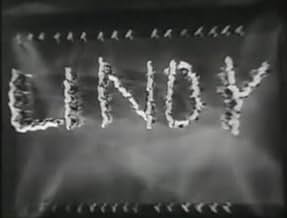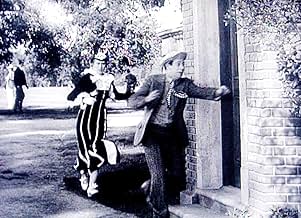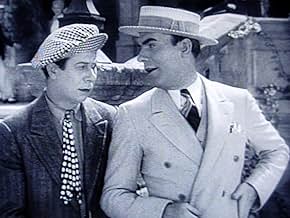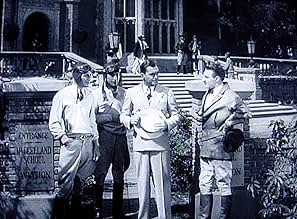Añade un argumento en tu idiomaAn eccentric inventor and his new flying machine are the focus of this musical comedy.An eccentric inventor and his new flying machine are the focus of this musical comedy.An eccentric inventor and his new flying machine are the focus of this musical comedy.
- Dirección
- Guión
- Reparto principal
- Premios
- 1 premio en total
Gus Arnheim and His Orchestra
- Gus ArnHeim's Orchestra
- (as Gus Arnheim and his Orchestra)
Loretta Andrews
- Chorus Girl
- (sin acreditar)
Mary Ashcraft
- Chorus Girl
- (sin acreditar)
Edna Callahan
- Chorus Girl
- (sin acreditar)
Richard Carle
- Hotel Manager
- (sin acreditar)
Tommy Conlon
- Undetermined Secondary Role
- (sin acreditar)
Nick Copeland
- Aviator with the Jokester
- (sin acreditar)
Janet Currie
- Chorus Girl
- (sin acreditar)
Mary Dees
- Chorus Girl
- (sin acreditar)
Reseñas destacadas
This was Lahr's first starring feature film. It is based on his stage hit of the same name. He is completely over the top. This wild stage persona can also be seen in his shorts for Educational, but by the time he made "The Wizard of Oz", he had begun to calm down. Charlotte Greenwood plays the role originally done by Kate Smith on Broadway. She and Lahr make a fine combination. This film includes a doctor's office sketch which is quite risqué and is of questionable taste. Lahr keeps the film from being boring, but his energy can become very tiring. The De Sylva, Brown and Henderson musical numbers from the original show have been deleted, but there are a couple of new Dorothy Fields-Jimmy McHugh songs, with Busby Berkeley style "choreography", and of course, Lahr gets a musical number to show his stuff. All fans of the Cowardly Lion should check out this film.
FLYING HIGH (Metro-Goldwyn-Mayer, 1931), directed by Charles Reisner, marked the motion picture debut of comedian Bert Lahr (1892-1967), best known today for his memorable performance as the Cowardly Lion in the musical fantasy, THE WIZARD OF OZ (MGM, 1939). Reprising his theatrical role of Rusty from George White's 1930 Broadway musical, the screen version is very much a showcase for Lahr, with co-star Charlotte Greenwood, who can always be counted on to deliver a hilarious performance, coming a close second as a man-chasing spinster whom Lahr's character describes as a woman who "makes love like an alley cat." Greenwood's role parallels what she'd previously done with another Broadway gone Hollywood entertainer, Eddie Cantor, in PALMY DAYS (Samuel Goldwyn, 1931). While Cantor continued to perform steadily in films through most of the 1930s, FLYING HIGH was to be Lahr's sole venture into the new medium until his return to the screen by 1937 in secondary roles. What PALMY DAYS and FLYING HIGH have in common is not so much having Broadway comics in the lead and Greenwood as their foil, but the benefit of dance director Busby Berkeley, in his pre-Warner Brothers days, whose two production numbers benefits FLYING HIGH more than the plot itself.
Bert Lahr stars as Emil "Rusty" Krause, a hack-eyed inventor of the "aerocopter" who's unable to find a backer for his product. He becomes partners with "Sport" Wordell (Pat O'Brien), who doesn't have any money either. Sport acquires an investor named Fred Smith (Guy Kibbee), who's just as broke as he is. After falling in love with Smith's daughter, Eileen (Kathryn Crawford), Sport works out an angle acquiring the much needed $500 through Pansy Potts (Charlotte Greenwood), a tall, homely waitress having just inherited $1600 from her late uncle, by promising her a would-be husband in that of Rusty (by using a photo of Clark Gable!!). With additional tunes by Jimmy McHugh and Dorothy Fields, the motion picture soundtrack is as follows: "Happy Landing" (sung by Kathryn Crawford); "It Will be the First Time for Me" (sung by Charlotte Greenwood and Bert Lahr); "Examination" (recited by Charles Winninger and female patients); "Dance Until the Dawn" (sung by Kathryn Crawford) and "Happy Landing" (reprise/cast).
Kathryn Crawford, no relation to Joan, (though slightly resembling vocalist Kitty Carlisle), sings two songs choreographed by Berkeley. "Happy Landing" contains some of the best Berkeley ingredients, including overhead camera shots of the chorus resembling airplanes and spelling out the names of great aviators of Byrd, Hawks, Lindy in formation. "Dance Until the Dawn," which comes a half hour later, is another Berkeley highlight, with chorus in dance formations with airplane propellers. Portions of this sequence were used in the theatrical documentary of THAT'S DANCING (1986), with the commentator concluding that, "Flying High never really got off the ground." Although portions of this 80 minute feature tends to drag, it's brought to life by its lively tunes, for the most part are as forgotten as the film itself.
Notable comedy highlights belong to Bert Lahr. Aside from he being chased around by Greenwood (having some experience going through the motions with Eddie Cantor), and his unusual medical examination by the doctor (played by a young looking Charles Winninger), he gets his chance to demonstrate his "aerocopter" at the air show by flying high enough to be out of this world. Other participants in the cast include Hedda Hopper; Gus Arnheim and his Orchestra; Clarence Wilson and Tom Kennedy (as the bully who picks on Rusty).
Rarely seen on commercial television since the 1960s, and never distributed on video or DVD, look for FLYING HIGH the next time it tail spins on Turner Classic Movies cable station. (** landing gears)
Bert Lahr stars as Emil "Rusty" Krause, a hack-eyed inventor of the "aerocopter" who's unable to find a backer for his product. He becomes partners with "Sport" Wordell (Pat O'Brien), who doesn't have any money either. Sport acquires an investor named Fred Smith (Guy Kibbee), who's just as broke as he is. After falling in love with Smith's daughter, Eileen (Kathryn Crawford), Sport works out an angle acquiring the much needed $500 through Pansy Potts (Charlotte Greenwood), a tall, homely waitress having just inherited $1600 from her late uncle, by promising her a would-be husband in that of Rusty (by using a photo of Clark Gable!!). With additional tunes by Jimmy McHugh and Dorothy Fields, the motion picture soundtrack is as follows: "Happy Landing" (sung by Kathryn Crawford); "It Will be the First Time for Me" (sung by Charlotte Greenwood and Bert Lahr); "Examination" (recited by Charles Winninger and female patients); "Dance Until the Dawn" (sung by Kathryn Crawford) and "Happy Landing" (reprise/cast).
Kathryn Crawford, no relation to Joan, (though slightly resembling vocalist Kitty Carlisle), sings two songs choreographed by Berkeley. "Happy Landing" contains some of the best Berkeley ingredients, including overhead camera shots of the chorus resembling airplanes and spelling out the names of great aviators of Byrd, Hawks, Lindy in formation. "Dance Until the Dawn," which comes a half hour later, is another Berkeley highlight, with chorus in dance formations with airplane propellers. Portions of this sequence were used in the theatrical documentary of THAT'S DANCING (1986), with the commentator concluding that, "Flying High never really got off the ground." Although portions of this 80 minute feature tends to drag, it's brought to life by its lively tunes, for the most part are as forgotten as the film itself.
Notable comedy highlights belong to Bert Lahr. Aside from he being chased around by Greenwood (having some experience going through the motions with Eddie Cantor), and his unusual medical examination by the doctor (played by a young looking Charles Winninger), he gets his chance to demonstrate his "aerocopter" at the air show by flying high enough to be out of this world. Other participants in the cast include Hedda Hopper; Gus Arnheim and his Orchestra; Clarence Wilson and Tom Kennedy (as the bully who picks on Rusty).
Rarely seen on commercial television since the 1960s, and never distributed on video or DVD, look for FLYING HIGH the next time it tail spins on Turner Classic Movies cable station. (** landing gears)
Bert Lahr starred in several musical revues on Broadway, but one of his rare successes in a 'book' musical (with a plotline) was 'Flying High', a topical comedy which scored points off the aviation contests and wing-walking stunts that were so popular in America at this time.
The plot is some froth about rival aviators competing for a transcontinental air race; the winner to receive a large cash prize, fame, and so forth. Gordon is the wealthy playboy pilot who wants to sink his skyhooks into sweet little Eileen Cassidy.
Bert Lahr, in fine form and looking surprisingly athletic, plays Rusty Krause, the airfield mechanic who is (somewhat unwillingly) engaged to Pansy (Charlotte Greenwood), who seems to be some sort of airport groupie. Rusty, who has no piloting experience, accidentally goes aloft in an experimental 'aero-copter'. Not willing to let her man fly away that easily, Pansy jumps on the tail of the 'copter just before it leaves the ground. Once they're up in the air, something goes wrong with the 'copter. While Rusty moans in terror, Pansy climbs out on the fuselage and fixes the rudder.
Charlotte Greenwood is one of my favourite actresses: funny, intelligent, and extremely athletic despite her tall gawky physique. She often played super-competent women strangely attracted to weakling men. She's an utter delight here, doing her airborne acrobatics (despite some bad process photography). When 'Flying High' ran on Broadway, Lahr's leading lady was Kate Smith ... yes, the moon-mountainous singer. I can't imagine how the stage production managed the climactic scene in the aero-copter, high above solid ground ... and I also can't imagine the very plus-sized Kate Smith as Pansy, enacting a stagebound version of Charlotte Greenwood's acrobatics in this movie. That's not a cheap crack about Kate Smith's girth; I'm forced to assume that her characterisation was very different from Greenwood's.
The funniest scene in this film is Lahr's medical examination, in which Doc Brown straps him into a revolving drum and sends it spinning rapidly while Lahr howls in agony. But the best gag of all comes in the same scene, while Lahr's feet are on the ground. (I'll set up the joke by mentioning that this movie was made during Prohibition, when every red-blooded American male carried a hip flask full of booze.) The doctor hands Lahr an empty bottle and tells Lahr to give him a 'specimen'. Lahr doesn't know what this means. Just as the doctor is about to explain, his phone rings. While on the phone, Doc Brown pantomimes to Lahr that he must fill up the bottle. As the doctor looks away, Lahr whips out his hip flask and fills the bottle with amber fluid. (I assume it's amber; this is a monochrome movie.) Doc Brown rings off the phone, just in time for Lahr to hand him a full bottle and announce: 'Here y'go, Doc. I could only spare a quart.' The sophisticated audiences on Broadway gave this line the biggest laugh of Lahr's career. It's a pity that Lahr is remembered only as the Cowardly Lion, and his brilliant comedy portrayals are forgotten. I'll rate 'Flying High' 8 out of 10.
The plot is some froth about rival aviators competing for a transcontinental air race; the winner to receive a large cash prize, fame, and so forth. Gordon is the wealthy playboy pilot who wants to sink his skyhooks into sweet little Eileen Cassidy.
Bert Lahr, in fine form and looking surprisingly athletic, plays Rusty Krause, the airfield mechanic who is (somewhat unwillingly) engaged to Pansy (Charlotte Greenwood), who seems to be some sort of airport groupie. Rusty, who has no piloting experience, accidentally goes aloft in an experimental 'aero-copter'. Not willing to let her man fly away that easily, Pansy jumps on the tail of the 'copter just before it leaves the ground. Once they're up in the air, something goes wrong with the 'copter. While Rusty moans in terror, Pansy climbs out on the fuselage and fixes the rudder.
Charlotte Greenwood is one of my favourite actresses: funny, intelligent, and extremely athletic despite her tall gawky physique. She often played super-competent women strangely attracted to weakling men. She's an utter delight here, doing her airborne acrobatics (despite some bad process photography). When 'Flying High' ran on Broadway, Lahr's leading lady was Kate Smith ... yes, the moon-mountainous singer. I can't imagine how the stage production managed the climactic scene in the aero-copter, high above solid ground ... and I also can't imagine the very plus-sized Kate Smith as Pansy, enacting a stagebound version of Charlotte Greenwood's acrobatics in this movie. That's not a cheap crack about Kate Smith's girth; I'm forced to assume that her characterisation was very different from Greenwood's.
The funniest scene in this film is Lahr's medical examination, in which Doc Brown straps him into a revolving drum and sends it spinning rapidly while Lahr howls in agony. But the best gag of all comes in the same scene, while Lahr's feet are on the ground. (I'll set up the joke by mentioning that this movie was made during Prohibition, when every red-blooded American male carried a hip flask full of booze.) The doctor hands Lahr an empty bottle and tells Lahr to give him a 'specimen'. Lahr doesn't know what this means. Just as the doctor is about to explain, his phone rings. While on the phone, Doc Brown pantomimes to Lahr that he must fill up the bottle. As the doctor looks away, Lahr whips out his hip flask and fills the bottle with amber fluid. (I assume it's amber; this is a monochrome movie.) Doc Brown rings off the phone, just in time for Lahr to hand him a full bottle and announce: 'Here y'go, Doc. I could only spare a quart.' The sophisticated audiences on Broadway gave this line the biggest laugh of Lahr's career. It's a pity that Lahr is remembered only as the Cowardly Lion, and his brilliant comedy portrayals are forgotten. I'll rate 'Flying High' 8 out of 10.
This seems like an opened-out play. The opening out is fine. There are some highly entertaining Busby Berkeley dance routines and Pat O'Brien is always fun.
Bert Lahr is an acquired taste never acquired by me. But Charlotte Greenwood is utterly delightful in this, as the spinster who sets her sights on him as her last best chance for marriage.
Her physical, somewhat self-mocking comedy is a precuser to that of Joan Davis a decade of so later. Both are treasures.
Bert Lahr is an acquired taste never acquired by me. But Charlotte Greenwood is utterly delightful in this, as the spinster who sets her sights on him as her last best chance for marriage.
Her physical, somewhat self-mocking comedy is a precuser to that of Joan Davis a decade of so later. Both are treasures.
I have not seen FLYING HIGH yet, so no opinion there, but wanted to respond to Lonesome Prospector's ridiculous and ignorant speculation that Bert Lahr could be copying Curly Howard. Just because you saw Curly first doesn't mean he came first.
Bert Lahr began his performing career in 1910. He worked in vaudeville for 17 years, before making his Broadway debut in 1927. According to his biographer (and son) John Lahr, Bert Lahr had established his "gnong gnong" sound before 1920, as he is working it into his cop-and-dancer vaudeville act with his then-wife in the late teens and early 20's.
Curly Howard had not thought about being a performer until 1932, when brother Samuel (Shemp) left Ted Healy's Stooges, and brother Moe asked little brother Jerry (Curly) to join. At this time, Bert Lahr had already made his feature film debut, and was midway through a career as a Broadway headliner. The Stooges were scrambling through various short subject departments until they wound up at Columbia in 1934. A careful observation of their development shows that Curly had not really set his "schtick" until 1934 or 1935.
You might not think he was a big deal because he made few successful movies, but dollar for dollar Bert Lahr was a much, much bigger star than Curly Howard. Moreover, at the conclusion of his career he performed in the American premiere of WAITING FOR GODOT, did Shakespeare. Aristophanes and Feydeau. Not to say that Curly Howard couldn't have done such things, but he was long dead of a stroke, perhaps precipitated by the years of beatings he'd received from his fellow stooges.
FLYING HIGH might not be much cinematically, but it is priceless artifact of theater history, preserving Lahr as he appeared on stage in his early peak years.
Bert Lahr began his performing career in 1910. He worked in vaudeville for 17 years, before making his Broadway debut in 1927. According to his biographer (and son) John Lahr, Bert Lahr had established his "gnong gnong" sound before 1920, as he is working it into his cop-and-dancer vaudeville act with his then-wife in the late teens and early 20's.
Curly Howard had not thought about being a performer until 1932, when brother Samuel (Shemp) left Ted Healy's Stooges, and brother Moe asked little brother Jerry (Curly) to join. At this time, Bert Lahr had already made his feature film debut, and was midway through a career as a Broadway headliner. The Stooges were scrambling through various short subject departments until they wound up at Columbia in 1934. A careful observation of their development shows that Curly had not really set his "schtick" until 1934 or 1935.
You might not think he was a big deal because he made few successful movies, but dollar for dollar Bert Lahr was a much, much bigger star than Curly Howard. Moreover, at the conclusion of his career he performed in the American premiere of WAITING FOR GODOT, did Shakespeare. Aristophanes and Feydeau. Not to say that Curly Howard couldn't have done such things, but he was long dead of a stroke, perhaps precipitated by the years of beatings he'd received from his fellow stooges.
FLYING HIGH might not be much cinematically, but it is priceless artifact of theater history, preserving Lahr as he appeared on stage in his early peak years.
¿Sabías que...?
- CuriosidadesThere was considerable pressure from the Hays Office to remove the examination scene from the movie, but MGM held firm, claiming they paid $100,000 for the rights to the play just for that particular scene. Eventually some aspects of that scene was removed when some exhibitors rejected the film. The TCM print contains the scene, but it may be the abbreviated version.
- PifiasTom Kennedy is menacing Bert Lahr because he threw an oil-soaked hat in his face. Pat O'Brien intervenes and punches oil-smudged Tom Kennedy in the stomach. Pat's cheeks are clean. Cut to Tom doubling over. Cut back to Pat with an oil smudge on his right cheek, even though Tom never touched him. Bert enters the shot offering Pat a hammer. Pat says "That's all right." Cut to long shot of Tom retreating and Pat wiping his face. No smudge in next close-up. So it appears there was more to the fight, but it was edited out.
- Créditos adicionalesThe credits appear as printed on the side of a dirigible.
- ConexionesEdited into La pelirroja (1932)
- Banda sonoraI'll Make a Happy Landing (the Lucky Day I Land You)
(1931) (uncredited)
Music by Jimmy McHugh
Lyrics by Dorothy Fields
Played during the opening credit and at the end
Sung by Kathryn Crawford and chorus and danced by the chorus in a production number
Played also as background music
Footage later used in Plane Nuts (1933)
Selecciones populares
Inicia sesión para calificar y añadir a tu lista para recibir recomendaciones personalizadas
Detalles
Taquilla
- Presupuesto
- 634.000 US$ (estimación)
- Duración
- 1h 20min(80 min)
- Color
Contribuir a esta página
Sugerir un cambio o añadir el contenido que falta





















